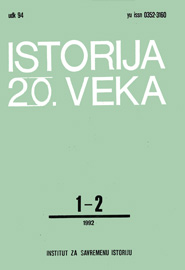DA LI SU POSTOJALE EKONOMSKE GRANICE UNUTAR JUGOSLOVENSKOG ISTORIJSKOG PROSTORA 1918 - 1941?
WERE THERE ECONOMIC BORDERS WITHIN THE YUGOSLAV HISTORICAL TERRITORY 1918 - 1941?
Author(s): Smiljana ĐurovićSubject(s): Economic history, Political history, Recent History (1900 till today), Pre-WW I & WW I (1900 -1919), Interwar Period (1920 - 1939), WW II and following years (1940 - 1949)
Published by: Institut za savremenu istoriju, Beograd
Keywords: Kingdom of Yugoslavia; economic borders; first half of 20th century; Nikola Tesla; modernization;
Summary/Abstract: The essential questional discussed in this article is whether economic borders existed within Yugoslavia between 1918 and 1941. The main aspects of the discussion are: 1. the boundaries of economic development: a) on which side of the border was Nikola Tesla, b) the boundaries of modernization on Yugoslavia's historical territory; 2. the Inner borders of the Balkans and the Yugoslav historical territory, and 3. the organization of the economy according to administrative areas (banovina), chambers, and social classes, from 1918 to 1941. Supporting the thesis that economy as such cannot, as an intermediary between Man and Nature, have limits, other than those sets by itself, the author deals, initially, with the Nikola Tesla phenomenon. This Serb from Lika, »from the Austro-Hungarian border«, who was permanently settled in New York in the last decade of the 19th Century, modernized the economy and human life on Earth with his discoveries in the field of electrotechnics, which also gave rise to new technologies. The author concludes that it is impossible to draw a boundary between the Serb Tesla and world economy, just as it is impossible to draw a boundary between world economy and the economy of Yugoslavia. The modernization and electrification of the new era did not know of borders between nations and states. Within Yugoslavia, however, it is possible to identify »borders of progress«, borders of modernization, that is, regions on the borders of which modernization came to a halt. This is viewed in the context of the general question concerning so called inner borders of the Balkan peninsula at the beginning of the 20th Century. The article presents the organization of the economy in the Kingdom of Yugoslavia, according to administrative areas (banovina), chambers and social classes, wherein the author insists on the term »organization« and not »division« of the country, because the subject is the formation of the new state.
Journal: Istorija 20. veka
- Issue Year: 1992
- Issue No: 1+2
- Page Range: 111-124
- Page Count: 14
- Language: Serbian

